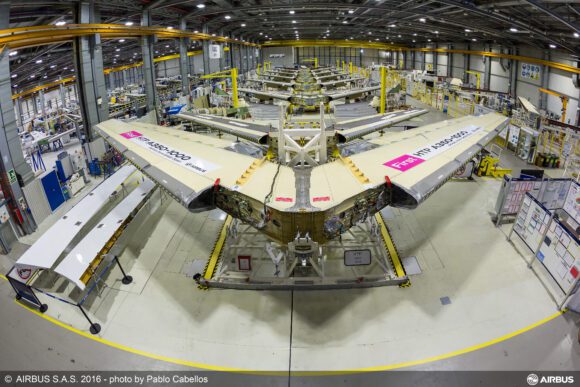
20211370 ZeroeOnBlueSky v12
Airbus will establish a new entity of its UpNext innovation subsidiary and a third Zero Emission Development Center (ZEDC) in Spain to help develop the future generation of hydrogen airliners, it announced on December 10. The two units strengthen the position of Airbus in Spain and partly compensate for the loss in the workforce since the closure of production sites related to the A380. Airbus Spain gets share in hydrogen program.
The new ZEDC in Spain will concentrate on the development of carbon fiber composite fuel tanks for the storage of liquid hydrogen for the ZEROe generation of future hydrogen airliners. The focus of the center will be on non-propulsive energy, systems for fuel cell cooling, and fiber optic.
Airbus established two ZEDCs in Nantes and Bremen in June that specifically are developing metallic hydrogen tanks in close partnership with other companies, like Arianespace. Carbon fiber tanks will likely be lighter than metallic ones but require more research and development. ZEDC Spain will partner with Airbus’ composite research center in Stade, near Hamburg.
Vice President of ZEROe, Glenn Llewellyn, told AirInsight in September that Airbus is learning from the automotive industry, specifically the truck industry, for the design of hydrogen tanks. In fact, these are giant thermos cans you might use to keep your coffee warm. In this case, they need to keep the liquid hydrogen at -253 degrees Celsius but add the complexity of cooling systems, plumbing, and other systems to pressure the LH2 again.
UpNext Spain will also be dedicated to the study and demonstration of hydrogen-powered, non-propulsive energies and future tanking operations. UpNext has its headquarters near Toulouse Blagnac. One of the current projects is ASCEND, which looks at superconductive materials in combination with cryogenic (super cold) technologies in electric and hybrid-electric propulsion systems. The idea is that superconducting distribution systems of cables plus a cryogenically cooled motor are two to three times lighter and improve the power-to-weight ratio. UpNext also develops the eXtra Performance Wing to improve efficiency and wing aerodynamics.
Airbus is already present in Spain through its Getafe site near Madrid, which designs, engineers, and manufactures components for all commercial aircraft programs as well as the horizontal tailplanes of the A330 and A350. The Illescas site near Toledo produces the composite empennage of all models and the lower wing cover for the A350, while Puerto Real near Cadiz produces lateral boxes for the horizontal stabilizer of the A330 and A350 plus elevators for the A320.
The Getafe site produces the horizontal tailplane for the A330 and A350. This was the first A350-1000 in 2016. (Airbus)
The Getafe and Albacete plants also perform the final assembly of the Tiger and NH-90 helicopters, while producing sub-assemblies for the H135. Airbus Defence & Space has two assembly sites in San Pablo and Tablada near Seville for the A400M airlifter and C-295 multi-role aircraft. Assemblies of the Eurofighter are also produced in Spain, while in Getafe, conversion of the A330 MRTT tanker is done.
Social unrest over future Puerto Real factory
This brings the total workforce of Airbus in Spain to 11.600. In response to the effects of the pandemic and worldwide reduction in staff, Airbus Spain needed to shed 900 jobs. This partly comes from the termination of the A380 program, for which the Puerto Real site produced the empennage and tailplanes that were then shipped to Hamburg.
Some 300 jobs related to the A380 project have been at risk. Tensions have been running high since last spring when Airbus announced its intention to close Puerto Real in 2023. This led to social unrest and actions from some 2.000 workers, many of which criticized the Spanish unions for conspiring behind their backs by agreeing with the closure of the factory. In November, hundreds of workers demonstrated in the streets of Cadiz.
CEO Guillaume Faury said in April during the Q1 results presentation that the large workshare in the A380 program made it difficult to prevent painful measures. But he added: “For the planes of the future, there will be a workshare as today. We are defining for Spain a good workshare as well as for other countries. It has to rely on competitiveness, it has to rely on innovation. That’s we are working with governments on research and technology, but there is a very clear scenario for Spain that from my perspective makes a lot of sense for Spain.”
While saying it will strengthen its position in Spain, the Airbus media statement doesn’t specify the number of jobs that UpNext and the new ZEDC will bring to Spain. Its release only says: “This new presence will leverage the expertise of Airbus Commercial Aircraft, Airbus Helicopters, and Airbus Defence and Space in Spain. Airbus UpNext gives future technologies a development fast-track by building demonstrators at speed and scale.”
Views: 10




